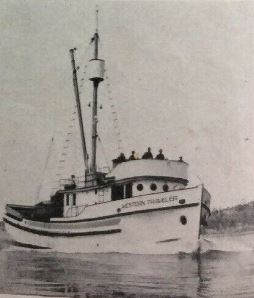
USCGC Onondaga (WPG-79), a United States Coast Guard cutter, was built by Defoe Boat Works in Bay City, Michigan, commissioned on 11 September 1934. From its commissioning until 1941, Onondaga was stationed at Astoria, Oregon, where she performed important law enforcement duties and rendered much assistance to ships in distress. Each year she patrolled the annual pelagic seal migration to the Pribilof Islands, and she attempted to prevent out of season halibut fishing.

Akatsuki was the twenty-first Fubuki-class destroyer, or the lead ship of the Akatsuki class, built for the Imperial Japanese Navy in the inter-war period. When introduced into service, these ships were the most powerful destroyers in the world. They remained formidable weapons systems well into the Pacific War.

USS YP-422 was a United States Navy yard patrol (YP) boat that served the United States Navy in World War II from 1942 to 1943. Built in 1941 as the fishing trawler Mist, she was acquired by the US Navy in June 1942 and was converted for naval use by George Lawley & Son of Neponset, Massachusetts. She was commissioned on 28 July 1942 and was put into service to patrol the waters around the Boston Navy Yard. The vessel was lightly armed with a 3-inch gun and two .30 caliber machine guns.
USS Charleston (PG-51), the fourth vessel to carry her name, was the second of two Erie-class patrol gunboats. Launched from the Charleston Navy Yard on 25 February 1936, and commissioned on 8 July 1936 and was part of the Atlantic Fleet.

USS Zumbrota (SP-93/YP-93) was a motor boat in the United States Navy.

USS Teal (AM-23/AVP-5) was a Lapwing-class minesweeper acquired by the United States Navy for the task of removing naval mines from minefields laid in the water to prevent ships from passing. The ship entered service in 1918, was converted into a seaplane tender in the 1920s and took part in World War II, serving primarily in Alaskan waters. Following the war, the ship was decommissioned and sold in 1948. Teal was named after the teal, any of several small, short-necked, river ducks common to Europe and the Americas.
USS Augury (AM-149) was an Admirable-class minesweeper built for the United States Navy during World War II and in commission from 1943 to 1945. In 1945, she was transferred to the Soviet Navy, in which she served as T-334.

USS Surveyor was an armed steamer that served in the United States Navy from 1917 to 1919. Prior to her U.S. Navy service, she operated as the survey ship USC&GS Surveyor for the United States Coast and Geodetic Survey in 1917, and she returned to that role after her U.S. Navy decommissioning, remaining in Coast and Geodetic Survey service until 1956.

USFS Eider was an American motor schooner in commission in the fleet of the United States Bureau of Fisheries from 1919 to 1940 and, as US FWS Eider, in the fleet of the U.S. Fish and Wildlife Service from 1940 to 1942 and again in the late 1940s. She ran a passenger-cargo service between Unalaska and the Pribilof Islands, and also carried passengers, supplies, and provisions to destinations on the mainland of the Territory of Alaska and in the Aleutian Islands. She occasionally supported research activities in Alaskan waters and the North Pacific Ocean, and she conducted patrols to protect Alaskan fisheries and marine mammals. In 1924, she provided logistical support to the first aerial circumnavigation of the world.

The USS YP-73 (ex-Corsair) was a converted fishing vessel which served as an auxiliary patrol boat in the U.S. Navy during World War II.

USS YP-17 was a wooden-hulled patrol vessel in commission in the fleet of the United States Coast Guard as CG-275 from 1925 to 1933, and in the fleet of the United States Navy as YP-17 from 1933 until 1941. She was captured by Japanese forces during the Japanese attack on Guam.

USS YP-74 (ex-Endeavor) was a converted fishing vessel which served as an auxiliary patrol boat in the U.S. Navy during World War II.

USS YP-400 was a seiner acquired by the U.S. Navy before completion during World War II to serve as a patrol boat.

USS YP-153 was a converted fishing vessel which served as an auxiliary patrol boat in the U.S. Navy during World War II.

USS YP-152 was a converted fishing vessel which served as an auxiliary patrol boat in the U.S. Navy during World War II.
USS YP-155 was a converted fishing vessel which served as an auxiliary patrol boat in the U.S. Navy during World War II.
USS YP-93 was a converted fishing vessel which served as an auxiliary patrol boat in the U.S. Navy during World War II.
USS YP-86 was a converted fishing vessel which served as an auxiliary patrol boat in the U.S. Navy during World War II.
USS YP-399 was a fishing vessel acquired by the U.S. Navy before completion during World War II to serve as a patrol boat.
USS YP-88 was a converted fishing vessel that served as an auxiliary patrol boat in the U.S. Navy during World War II.











